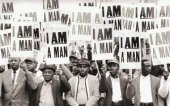Juba, Juba,
Juba this and Juba that, Juba killed a yellow cat
And give us a double trouble, Juba.
You sift-a the meal, you give me the husk
You cook-a the bread, you give me the crust.
You fry the meat, you give me the skin
And that’s where my mama’s trouble begin.
Juba, Juba, you give me the double-trouble, Juba.
Juba-this, and Juba-that and Juba killed the yellow cat.
Juba-up and Juba-down and Juba all around the town, Juba.
Massa killed the big old duck and give us all the bones to suck,
Massa killed the big old goose and give us all the bones to chew.
My old massa promised me, when he died he’d set me free.
He lived 'til his head got slick and bald
He give up the notion of dying at all.
Juba this and Juba that, Juba killed a yellow cat
And give us a double trouble, Juba.
You sift-a the meal, you give me the husk
You cook-a the bread, you give me the crust.
You fry the meat, you give me the skin
And that’s where my mama’s trouble begin.
Juba, Juba, you give me the double-trouble, Juba.
Juba-this, and Juba-that and Juba killed the yellow cat.
Juba-up and Juba-down and Juba all around the town, Juba.
Massa killed the big old duck and give us all the bones to suck,
Massa killed the big old goose and give us all the bones to chew.
My old massa promised me, when he died he’d set me free.
He lived 'til his head got slick and bald
He give up the notion of dying at all.
envoyé par Bernart Bartleby - 19/4/2015 - 21:21
×
![]()









Nel disco di Candie e Guy Carawan intitolato “Freedom Now - Songs For A New America” publicato nel 1968.
Poi anche nel disco di Bessie Jones “Step It Down: Games For Children By Bessie Jones” del 1979.
“Juba”, o “Pattin’ Juba” (“Djouba” ad Haiti) era prima di tutto una danza di antica origine africana che gli schiavi neri nella Guyana olandese, nei Caraibi e nel sud degli States ripresero ed adattarono forse già nel XVII secolo, quando l’uso di strumenti, in particolare a percussione, era severamente vietato e punito nelle piantagioni, perchè i bianchi pensavano che servisse agli schiavi per trasmettere tra loro informazioni in codice.
A metà 800 la danza - uno o due solisti che eseguono passi frenetici percuotendo rumorosamente i piedi, rispondendo agli astanti che li incitano con richiami ed il battito ritmico delle mani - cominciò ad essere accompagnata da strumenti e dal canto. Il testo di Bessie Jones le era stato insegnato dal nonno e non era altro che il racconto di una vita da animale da soma, costretto a lavorare dall’alba al tramonto e a mangiare gli scarti della tavola del “massa” (master), il padrone bianco.
La “Juba dance” è alla base di balli moderni come il “Charleston”, la “Tap dance” e lo “Stepping”.
Insomma, Fred Astaire e Ginger Rogers non hanno inventato nulla...